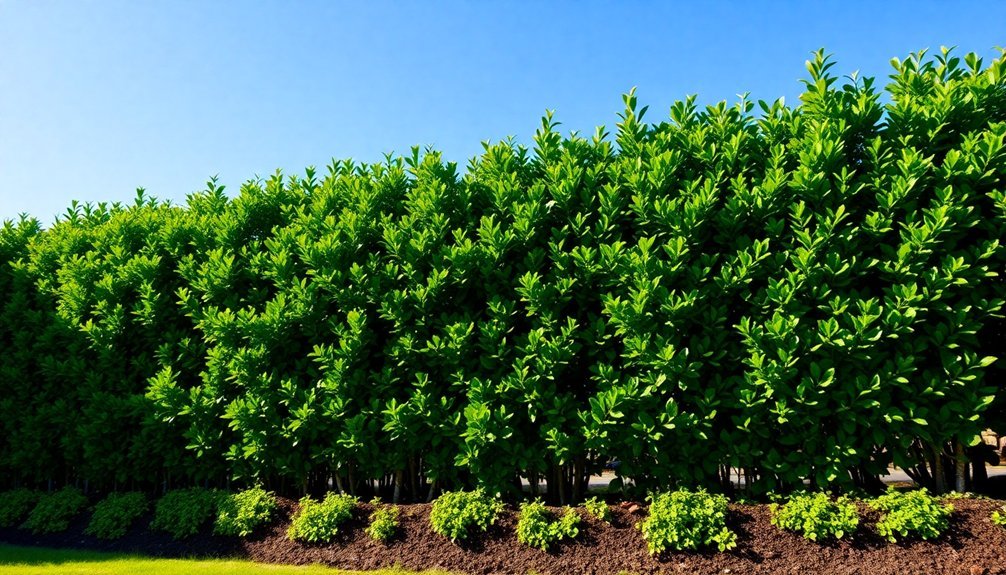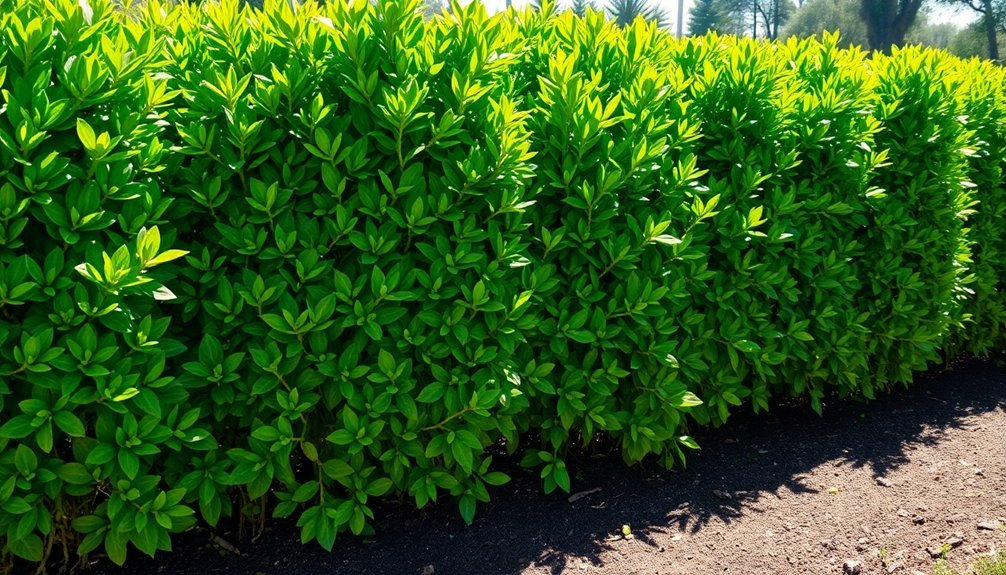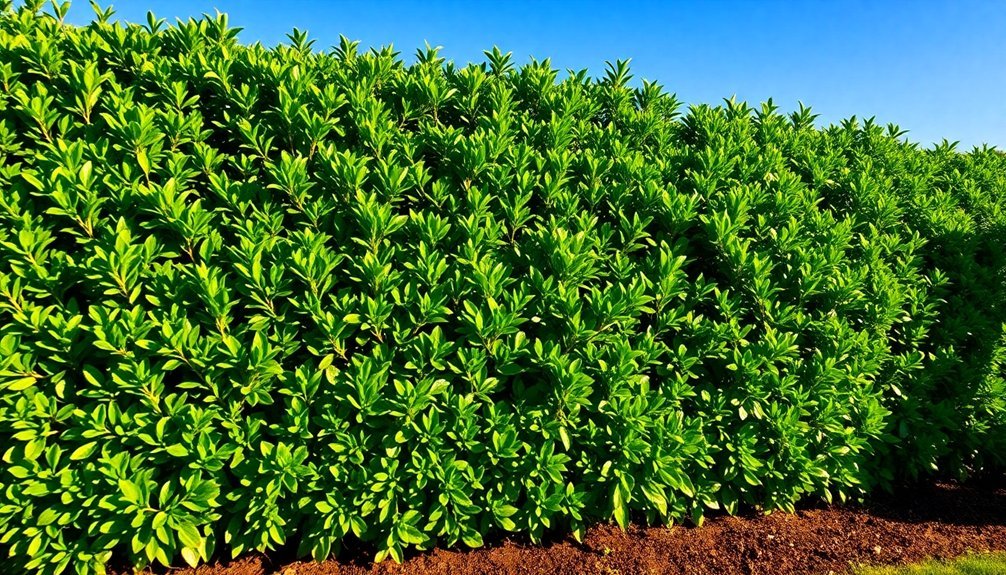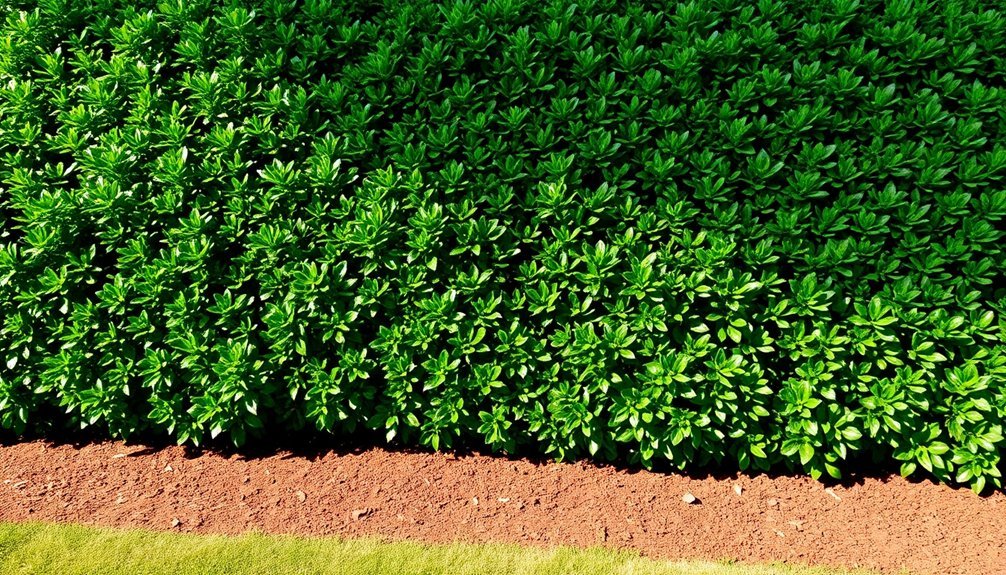The fastest-growing privacy hedges include Leylandii (90cm yearly), Green Giant Arborvitae (3-4 feet annually), English Laurel (3 feet per year), Privet, and Emerald Green Arborvitae. You'll get the best growth by planting in spring or fall in well-drained soil mixed with compost. Water deeply twice weekly for sandy soil, less for clay. Proper pruning at 45-degree angles encourages denser growth. The right maintenance techniques can turn these rapid growers into your perfect living wall within seasons.
Top 5 Lightning-Fast Privacy Hedges for Immediate Results

Five exceptional privacy hedges can transform your outdoor space in record time, offering the seclusion you crave without the wait.
Leading the pack is Leylandii, growing up to 90cm annually to create a dense screening effect when properly maintained.
Leylandii transforms boundaries at lightning speed, creating impenetrable green walls within months of planting.
English Laurel matches this impressive pace, shooting up 3 feet yearly while resisting deer and thriving in various light conditions.
Green Giant Arborvitae grows 3-4 feet per year and stays evergreen year-round with minimal deer damage. Planning a staggered landscape design can maximize growth potential and enhance coverage more quickly.
For structured gardens, Privet grows 30-60cm annually and adapts to most soils, though it needs frequent pruning.
Emerald Green Arborvitae offers a more moderate growth rate at 12-18 inches yearly but compensates with year-round color and minimal maintenance requirements.
The Science Behind Rapid Hedge Growth Rates
The remarkable speed of fast-growing hedges stems from specific genetic traits that control cell division rates and resource allocation within the plant.
You'll notice that soil chemistry greatly impacts growth rates, with the ideal pH level and nutrient balance enabling roots to efficiently absorb essential minerals.
When you provide the perfect combination of genetics, sunlight, pruning techniques, and soil conditions, you're effectively creating a biological growth accelerator for your privacy hedge. Incorporating organic matter during soil preparation significantly enhances fertility and improves drainage, creating optimal conditions for rapid establishment.
Growth Factors Explained
Understanding rapid hedge growth requires examining several interconnected biological and environmental elements.
When you're planning privacy hedges, recognizing these growth factors helps you select species that will thrive in your specific conditions.
- Temperature range greatly impacts growth rate, with most fast-growing hedges performing best between 15°C and 30°C.
- Sunlight exposure determines energy production—full sun typically accelerates growth in species like Cherry Laurel and Leyland Cypress.
- Soil moisture and quality directly affect nutrient uptake, with consistent watering promoting the 60-90 cm annual growth seen in top performers.
- Maintenance practices like strategic pruning and mulching stimulate lateral growth, creating denser privacy screens faster.
Your regional climate will ultimately determine which fast-growing species will provide the quickest privacy solution for your landscape. Many varieties can grow over 1 foot per year, with some reaching up to 4 feet annually in optimal conditions.
Soil Chemistry Impact
Beneath the surface of your thriving hedge lies a complex chemical world that directly influences growth rates and overall plant health. Your chosen hedge species will actively modify the soil beneath it, creating a unique chemical signature that strengthens over time.
Older hedges demonstrate more pronounced soil chemistry effects due to accumulated leaf litter and root activity. You'll notice faster growth when essential nutrients like nitrogen, phosphorus, and potassium are abundant in your soil. These elements drive nutrient cycling processes that fuel rapid hedge development.
The area directly under your hedge's canopy experiences the strongest chemical modifications. This zone creates a microenvironment that can boost growth rates substantially. Hedgerows significantly contribute to environmental goals by storing approximately 40 tonnes more carbon per hectare compared to surrounding grassland.
For maximum growth potential, protect your hedge's soil carbon by maintaining organic matter levels and minimizing disturbance that could trigger decomposition and nutrient loss.
Best Soil Conditions for Accelerating Hedge Establishment

Creating ideal soil conditions for your privacy hedge isn't just beneficial—it's essential for rapid establishment and long-term vigor.
Most fast-growing hedges like Leyland Cypress and Wax Leaf Privet adapt to various soil types, but they'll thrive with proper preparation.
- Dig planting holes twice the container width and mix native soil with compost for best drainage and nutrition.
- Incorporate bone meal or starter fertilizer during planting to stimulate robust root development.
- Confirm proper pH levels—slightly acidic to neutral works best for most privacy hedges including Carolina Cherry Laurel.
- Add a 2-3 inch layer of mulch around your newly planted hedge to retain moisture and suppress competing weeds.
The Wax Myrtles particularly benefit from this soil preparation as they naturally tolerate diverse soil conditions in Texas landscapes.
Water deeply once weekly during the first year to encourage deep root growth and faster establishment.
Seasonal Planting Strategies for Maximum Growth Speed
Spring planting gives your privacy hedge perfect mild conditions to establish strong roots before summer's growth spurt.
Fall planting reduces transplant shock as cooler temperatures encourage root development while the plant remains dormant above ground.
You'll need consistent deep watering techniques throughout summer months, especially for newly planted hedges, to prevent stress and maintain ideal growth rates. When selecting plants, consider arborvitae trees for their columnar shape and affordability if you want instant privacy.
Spring Planting Benefits
When homeowners aim for privacy solutions, the timing of planting can greatly influence success rates.
Spring offers ideal conditions for establishing fast-growing hedges by providing the perfect balance of warmth and moisture that accelerates root development.
Your newly planted hedges will benefit from:
- Warmer soil temperatures that stimulate root growth and establishment
- Natural spring rainfall that reduces watering needs and stress on young plants
- Gentle weather conditions that allow plants to acclimate before summer heat
- Extended growing season ahead to maximize first-year height gains
Selecting species like Leyland Cypress can dramatically reduce the wait time for establishing an effective privacy screen due to their rapid vertical growth patterns.
Fall Root Establishment
While spring planting capitalizes on warming conditions, fall offers a strategic alternative for privacy hedge installation with unique advantages for root development. When you plant in autumn, cooler temperatures reduce stress on new plants while the soil remains warm enough for roots to establish before winter dormancy. This timing is especially beneficial for establishing Thuja varieties which thrive when given adequate time to develop roots before summer heat arrives.
| Benefits | Your Results |
|---|---|
| Less water stress | You'll save time and resources |
| Strong root system | Your hedge survives winter confidently |
| Reduced transplant shock | You'll see less wilting and leaf drop |
| Earlier spring growth | Your privacy screen appears faster |
Apply a 3-inch layer of mulch around your new plantings to retain moisture and protect developing roots. For ideal establishment, water consistently until the first frost and consider applying an October fertilizer application specifically formulated for root development in zones 5-8.
Summer Watering Techniques
How effectively you water your privacy hedge during summer can dramatically influence its establishment and growth rate. With temperatures soaring, your newly planted privacy screen needs consistent moisture to develop strong roots and lush foliage.
For best results during summer months:
- Water in early morning to minimize evaporation and disease risk, allowing plants to absorb moisture before peak sun.
- Install drip irrigation or soaker hoses that deliver water directly to roots, reducing waste and improving efficiency.
- Adjust your watering schedule based on soil type—twice weekly for sandy soil, less frequently for clay soil.
- Monitor soil moisture by inserting your finger an inch deep near roots; water when it feels dry.
During the first few growing seasons, increasing watering frequency helps establish a drought-tolerant hedge that will require less maintenance in future years.
Consider incorporating water-saving gels in potting soil to retain moisture and reduce watering frequency during heatwaves.
Pruning Techniques to Stimulate Faster Hedge Development
To accelerate your privacy hedge's development, strategic pruning plays an essential role in promoting denser, fuller growth. By trimming regularly between May and August, you'll stimulate new shoots and create a thicker barrier faster. Unattended privet hedges can become sparse and uneven if not properly maintained.
| Pruning Technique | Growth Benefit |
|---|---|
| Top trimming | Encourages side branching |
| 45-degree angle cuts | Promotes new shoot emergence |
| Tapered shaping | Guarantees lower branches receive sunlight |
| Multiple yearly prunings | Accelerates overall density |
| Removing 1/3 of height | Stimulates robust base growth |
Maintain a wider bottom than top to prevent die-back from shade. For privet hedges, which grow about 12 inches annually, implement at least two pruning sessions yearly. Use hand pruners for precision cuts on branches under 3/4 inch and power trimmers for larger areas—always wearing proper safety gear.
Watering and Fertilization Secrets for Explosive Growth

You'll see remarkable growth by installing timers on your irrigation system to deliver water consistently when hedges need it most.
Your watering schedule should shift with the seasons—more frequent in summer heat and reduced in cooler months to prevent root rot.
Apply balanced fertilizers in early spring to kickstart growth and again in mid-fall to strengthen roots before winter, adjusting quantities based on your specific hedge variety and soil conditions. For optimal results, make sure to inspect regularly for any signs of pests or diseases that could impede your hedge's rapid growth.
Timed Watering Techniques
Mastering the timing of your hedge watering can accelerate growth by up to 40% compared to random watering schedules.
The early morning hours between 2-7 am provide ideal conditions as evaporation is minimal, allowing more water to reach the root system where it's needed most.
For explosive hedge growth, implement these strategic watering practices:
- Use automated timers to maintain consistent watering schedules, reducing both labor and human error
- Employ the cycle-and-soak method by dividing irrigation into smaller intervals to prevent runoff
- Water deeply every 2-3 days for 1-2 hours during dry periods to encourage deep root development
- Adjust your system seasonally with weather-based controllers that respond to environmental conditions
For newly planted privacy shrubs, you should water at least twice a day during the first week to help mitigate transplant shock and ensure proper establishment.
Seasonal Fertilizer Schedule
While consistent watering promotes robust hedge development, your fertilization strategy ultimately dictates growth potential and long-term privacy screen success.
Apply balanced, slow-release fertilizers in early spring when new growth emerges, particularly for deciduous varieties.
For maximum results, introduce a second application in late summer or early autumn, especially for evergreens.
Test your soil first to identify specific nutrient deficiencies and adjust your NPK ratio accordingly.
After pruning, fertilize to support recovery and new growth.
Loosen compacted soil before application to improve nutrient absorption.
In urban areas with poor soil quality, incorporate organic mulch to enhance soil structure.
Remember that moist, well-aerated soil considerably improves fertilizer uptake.
For newly planted hedges, use phosphorus-rich formulations to establish strong root systems that support rapid vertical growth. High phosphorus options like bone meal provide exceptional support for developing extensive root systems that fuel above-ground expansion.
Spacing and Layout Tips for Quick Privacy Screens
Creating an effective privacy hedge requires strategic planning of your space and plant placement. For fast results, space your plants closer together—typically 12-24 inches apart for rapid growers—while still accounting for their mature width.
Consider arranging them in double rows with a staggered formation to create a denser barrier that establishes privacy more quickly.
- Choose evergreens as your primary plants for year-round screening and minimal maintenance.
- Prepare soil thoroughly with organic matter before planting to accelerate growth.
- Plant during fall or early spring when roots can establish before extreme weather hits.
- Consider a mixed-species approach to guarantee continuous privacy if one plant type struggles.
For narrow spaces, a single row works well, but multiple rows provide maximum screening when space allows. Incorporating different plant varieties with varying heights and textures creates visual interest while maximizing the effectiveness of your privacy screen.
Climate Considerations When Selecting Fast-Growing Varieties

Selecting fast-growing hedges for privacy requires careful consideration of your local climate, as the wrong choice can lead to stunted growth or plant failure. Check your hardiness zone first, then assess specific conditions like coastal exposure, shade levels, and drought frequency. Several varieties offer rapid growth rates that can establish your privacy screen within just a few growing seasons.
| Climate Type | Recommended Varieties | Key Considerations |
|---|---|---|
| Hot/Dry | Italian Cypress, Burning Bush | Prioritize drought resistance, implement water management |
| Coastal | Bamboo, Salt-tolerant species | Choose wind-resistant varieties that tolerate salinity |
| Cold | Thuja North Pole, Emerald Green | Look for winter burn resistance and cold hardiness |
| Shaded | Thuja Wintergreen | Expect slower growth, adjust spacing accordingly |
Remember that soil quality greatly impacts growth rates regardless of climate. Plants like Nellie Stevens Holly show excellent adaptability across various conditions, while others thrive only in specific environments.
Comparing Evergreen vs. Deciduous Speed-Growing Options
Beyond climate considerations, the choice between evergreen and deciduous varieties represents one of the most significant decisions for homeowners seeking fast-growing privacy hedges.
Evergreens provide year-round privacy while deciduous options often grow faster but lose foliage seasonally.
- Evergreen Champions: Green Giant Arborvitae dominates with growth rates of 3-5 feet annually, while Leyland Cypress and Schipka Cherry Laurel can reach 3 feet per year.
- Deciduous Speedsters: Burning Bush and Mock Orange grow rapidly but require more pruning to maintain their form.
- Maintenance Tradeoffs: Evergreens typically need annual pruning while deciduous varieties may require more frequent shaping.
- Visual Impact: Deciduous options like Burning Bush offer dramatic seasonal color changes that evergreens can't match.
Natural Privacy Walls: Installation Best Practices

To establish a natural privacy wall that thrives for years to come, proper installation forms the foundation of your hedge's success.
Begin by digging trenches that are two to three times wider than your plants' root balls, loosening the soil at the bottom with a garden fork to improve drainage.
Prepare generous trenches with loosened soil for your hedge plants—they'll reward your initial effort with robust growth.
Space your shrubs three to four feet apart to allow sufficient room for growth while ensuring complete coverage.
Before you start digging, verify you're planting within your property boundaries and away from underground utilities.
For non-living screens, select durable materials like wood or metal, and always check local building codes for compliance.
Regular watering during the first year is essential for establishing strong root systems, setting the stage for a thriving, long-lasting natural privacy wall.
Common Mistakes That Slow Down Hedge Growth
When establishing a privacy hedge, several common mistakes can considerably delay your hedge's development, leaving you waiting years longer than necessary for the privacy you desire.
Poor timing of trims disrupts natural growth cycles, with evergreens needing late spring cuts and deciduous varieties preferring winter dormancy periods.
Over-pruning stresses plants and creates patchy appearances that take seasons to recover from. Meanwhile, neglecting proper shaping—especially maintaining a wider base than top—results in uneven growth and sparse lower sections.
- Using dull tools that tear instead of cleanly cut branches, inviting disease
- Trimming flowering hedges before they bloom, eliminating potential flowers
- Heavy autumn pruning that leaves plants vulnerable to frost damage
- Ignoring post-trimming maintenance like debris removal that harbors pests
Multi-Species Hedgerows for Year-Round Privacy
While avoiding common growth-slowing mistakes is important, your hedgerow strategy itself can make a significant difference in privacy effectiveness.
Multi-species hedgerows offer superior year-round coverage compared to single-species plantings.
A diverse hedgerow creates a living privacy screen that remains effective through every season's challenges.
Combine evergreen varieties like holly or arborvitae with fast-growing deciduous plants such as sugar hackberry and sweet gum. This approach creates multiple layers—canopy trees, mid-level shrubs, and ground cover—for maximum density and visual interest throughout the seasons.
Beyond privacy, you'll gain impressive environmental benefits: increased biodiversity, wildlife habitat, erosion control, and carbon sequestration.
You'll also enjoy practical advantages including noise reduction, wind protection, and potentially lower maintenance costs than traditional fencing.
Native species work particularly well, adapting to your local climate while supporting pollinators and creating wildlife corridors that enhance your property's ecological value.
Maintenance Calendar for Rapid-Growing Living Barriers
Maintaining rapid-growing hedges requires a strategic calendar approach that changes with the seasons, ensuring your living privacy barrier develops quickly and remains healthy year-round.
Your maintenance schedule should align with natural growth cycles and seasonal needs.
- Winter (January-February): Inspect dormant hedges and perform structural pruning to prepare for spring growth bursts.
- Spring (March-April): Remove winter debris, prune non-blooming varieties, and apply organic fertilizer to fuel the growing season.
- Summer (May-August): Provide consistent watering during dry spells and perform light trims to maintain shape and encourage density.
- Fall (September-December): Give hedges a final trim before winter, clear fallen leaves, and apply mulch to protect roots from freezing temperatures.
Follow this calendar diligently, and you'll enjoy a thriving, dense privacy screen that grows at maximum speed.
Frequently Asked Questions
How Do Privacy Hedges Affect Home Value and Resale Potential?
Privacy hedges boost your home's value by enhancing curb appeal and offering sought-after seclusion. You'll likely sell faster and for more money when you've maintained attractive hedges that create private outdoor spaces.
Can Fast-Growing Hedges Damage Nearby Foundations or Underground Utilities?
Yes, fast-growing hedges can damage your foundation and utilities. Their aggressive roots may cause soil subsidence, invade foundation cracks, and wrap around pipes. Install root barriers and choose less invasive species to protect your home.
Are There Low-Allergen Options for People With Seasonal Allergies?
Yes, you'll find several low-allergen hedge options like Northern Bayberry, Bamboo, Italian Buckthorn, and Hardy Hibiscus. These plants produce minimal pollen while still providing privacy and can help filter airborne allergens.
What Wildlife Do Different Hedge Species Attract or Repel?
Different hedge species impact wildlife notably. You'll attract birds and pollinators with hawthorn, blackthorn, and holly, while yew, bamboo, and monoculture plantings tend to repel or limit wildlife diversity in your garden.
How Do Mature Heights Compare Between Speed-Growing Varieties?
You'll find Green Giant Arborvitae reaches 40-60 feet, while Leyland Cypress can exceed 70 feet. English Laurel grows smaller, and Chindo Viburnum typically stays between 10-15 feet. Thuja 'Smaragd' remains more compact than Green Giant.
In Summary
You'll transform your outdoor space with these fast-growing privacy hedges when you follow the right planting, pruning, and maintenance techniques. Remember, success depends on choosing the appropriate species for your climate, preparing ideal soil conditions, and avoiding common growth-inhibiting mistakes. With consistent care and patience, you'll enjoy a lush, natural privacy barrier in less time than you'd expect—creating your own secluded sanctuary within seasons, not years.





Leave a Reply